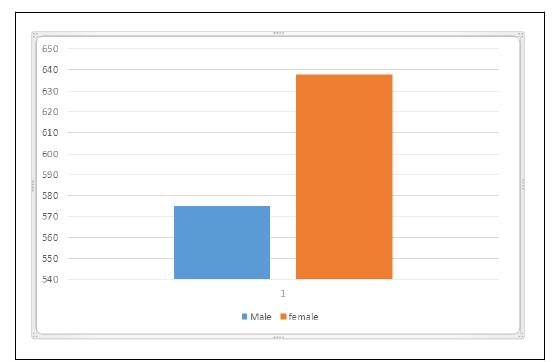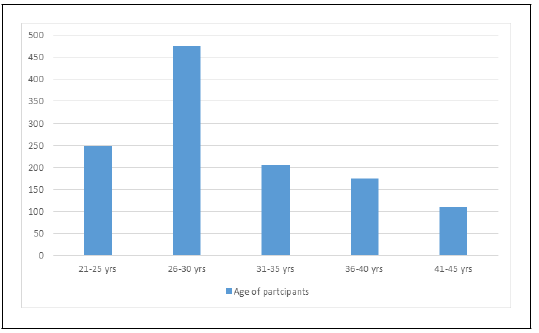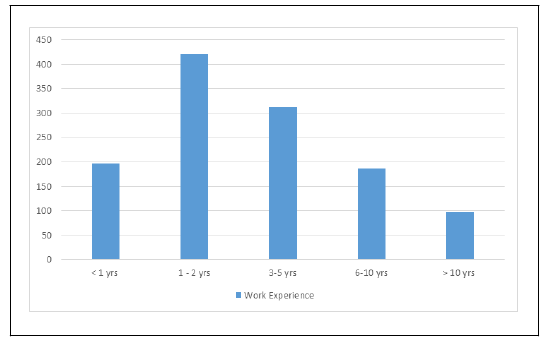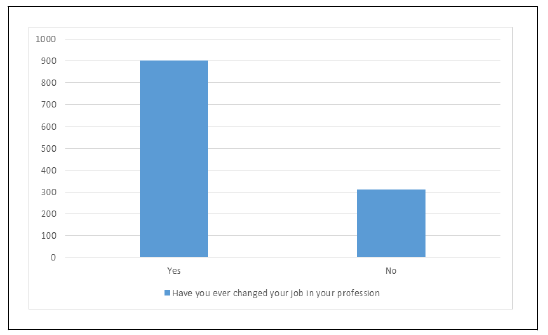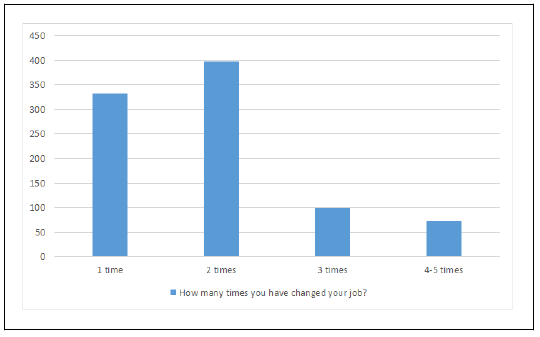Factors Influencing Job Turnover in Physical Therapy
Shamsa Rattani1*, Kanwal Lalwani1 and Muhammad Hussain Nagori2
Department of Physiotherapy, Isra Institute of Rehabilitation Sciences, Isra University, Hyderabad, Sindh, Pakisthan
- *Corresponding Author:
- Shamsa Rattani
Department of Physiotherapy, Isra Institute of Rehabilitation Sciences,
Isra University,
Hyderabad, Sindh, Pakisthan,
Tel: 92 3363783377;
Email: drshamsarattani@gmail.com
Received: January 24, 2023, Manuscript No. IPPR-23-16103; Editor assigned: January 28, 2023, PreQC No. IPPR-23-16103 (PQ); Reviewed: February 13, 2023, QC No. IPPR-23-16103; Revised: March 02, 2023, Manuscript No. IPPR-23-16103 (R); Published: March 29, 2023, 10.36648/J Physiother Res.7.3.159
Citation: Rattani S, Lalwani K, Nagori MH (2023) Factors Influencing Job Turnover in Physical Therapy. J Physiother Res Vol.7 No.3: 159.
Abstract
Background: The need, demand and importance of physiotherapist are increasing gradually as their role is in every aspect of life. Job turnover is an issue which every health organization is facing. Job turn have negative impact on health organization as it decreases the trained, experienced professionals which decreases the efficiency of health services, increases the turnover cost. Very fewer studies are performed about the factors on job turnover in physical therapy and these factor are varying on different geographic so it is important to identify these factors to decrease the job turnover, improve retention of physiotherapist and provide better quality of services.
Objective: This study aimed to find out the factors that influence job turnover in physical therapy.
Methods: Study was conducted among Physiotherapists. Sampling was convenient. Data was collected by means of a pre design questionnaire, after conducting a pilot study. The data analysis was done by using Statistical Package for Social Sciences (SPSS) 21 version.
Results: Questionnaires of 1213 participants were completed and returned back for analysis (response rate of 100%). 869 physiotherapists consider that insufficient salary to meet financial needs cause of leaving the job as it shows highest percentage as compare to other factors while 414 physiotherapists consider that unsatisfactory interaction with supervisors in physical therapy department is the least factor which can cause job turnover.
Conclusion: Our findings indicate that majority of physical therapist regards that the lack of sufficient remuneration, lack of promotions and insufficient fringe benefits are the most leading contributing factor which ultimately cause job turnover. Awareness of these factors will help to deal with turnover so that we can improve physiotherapist retention.
Keywords
Efficiency; Physical therapy; Job turnover; Physiotherapist retention
Introduction
Overview
Job turnover is a considerable issue which not only generates impact on staff members but also it has high impact on institution itself. Fewer studies were performed on employee intention to leave the job in Pakistan. Much of the studies are done on the staff recruitment but fewer researches were performed to find out the factors that causes turnover and retention based on the different chronograph locations and different health care professionals [1]. Studies on the factor influence job turnover in physiotherapy have not done yet. All institutions have different ratio of job turnover depending on area to area. Generally nongovernmental sectors have high ratio of turnover. It has been observed that female ratio is high in turnover and discontinuity in profession which is matter of concern and must be assess. The average yearly report has highest rate of turnover in distant areas in health care system. Today as the pattern of diseases and disabilities is changing day by day the need of allied health professional in which physiotherapist are included is becoming an important part of rural health team [2].
Job turnover
Job turnover is a mobility of a job from one location to other without changing the professional. According to cotton and tuttle turnover is defined as estimation of the chances of an individual to stay in an organization. Price describes it as the ratio of staff members who quit their jobs in a specific period with the average total staff present during that period in an organization [3].
Cost of turnover
Employees are the pillars of an organization due to that reason employee turnover are one of the leading problems of modern organization. It has devastating effects through direct and indirect expenditure on the institution. Staff selection, assembling, induction and training to new workers causes direct expense while learning, decrease in self esteem, decrease in worker coherence relation, burden to remaining staff are included in indirect expense. Institutions have to pay cost to hire and train new employees. It has been also noticed that turnover also causes negative outcome to education system as the shortage of faculty of physiotherapist causes teacher training and development expense [4].
Positive in luence of job turnover
Some turnover has positive influence on the health institution as it promotes and produce the new advance skills, techniques, methods, thoughts, resources, workforces. It provides opportunities to the physiotherapist to practice in different areas of settings. It promotes the substitution of poor skilled individuals and retired individuals. But harmful effects are beyond the benefits of job turnover [5].
Negative outcomes of job turnover
High rates of staff turnover leads to depletion of trained, expert, talented health care professionals due to which the people who acquire the care will get lower than desirable. This results in decrease quality of care of community and increase the cost of turnover. Institution need to pay high cost to hire and train new employees to enhance quality of services while other workers begin to perceive discomfort, displeasure with their jobs as its fact that job turnover create influence not only on institution but as well as on other workers. It has been noticed that turnover has increase in rural areas because they are unable to maintain health care staff retention due to which they faces problems including inadequate availability of professionals, when they are needed results in poor health status and issues in providing valid and constant health care services. It also causes physiotherapist staff deficiency which leads to decline in efficiency of organization due to this the workload increases on rest of the physiotherapist about the patient care. Time is needed to choose the new physiotherapist so it is important to find out the factors that causes turnover to increase staff retention. And to deal with turnover factors in advance to prevent its adverse outcomes [6-9].
Factors in luence job turnover
Factors that contribute job turnover eventually decrease retention are divided into two categorize administrative and individual factors. According to Odom, Boxx and Dunn devotion, group work coherence, satisfaction to job are three elements which have important influence with reference to turnover intention. Following are the factors that contribute job turnover [10].
• Charm of new job, poor communication between workers and administrative, poor work setting, less opportunities to enhance oneself skills, poor salary package.
• Causes of poor retention include substitute career option, poor career promotion, staff politics, poor resources, increase workload.
• Unjustified promotion, disappointment, annoyance, job stress, to perform such activities that are against to one’s own principles.
• Demographics and biographic issues.
Employee job dissatisfaction causes high ratio of turnover intention which eventually results to actual turnover. Job turn over and job satisfaction are inverse to each other if one increases other decrease. Many researches performed in variety of settings which indicate negative relation between factors of job satisfaction and intention to leave. Job stress is consequence of turnover and it is one of the reasons for decrease in satisfaction of physiotherapist which results in job turnover, burnout, work related problems, increase in absenteeism. Some employees’ feels unjust in their jobs like politics in an organization between workers, managers can be the consequence of high ratio of turnover in many institutions this causes tension and dissatisfaction which leads to explore other jobs such as if a worker wants maternal off, he will leave the job if his manager does not support him. It is important to find out the reasons for employee dissatisfaction because if they are not recognizing it will cause serious issues for an institution. The domains of dissatisfaction are indicator for change, improvement and modifications this can only occur when the measurement of job satisfaction were known and factors were already determined so that it will aid to establish certain steps to increase the degree of satisfaction which ultimately enhance the quality of care provided by rehabilitative professionals to the individual. Hence it is necessary to find out the factors causing job turnover to avoid the shortage of workforce [11].
Materials and Methods
Study design
This study is a cross sectional research survey.
Participant recruitment: Physiotherapists of Hyderabad, Karachi and Nawabshah were selected.
Duration of study: Duration of study was six months.
Sampling technique: Convenient non probability sampling technique was used.
Sample size: Sample size of 1213 physiotherapists was selected.
Sample selection
Inclusion criteria:
• Both male and female physiotherapists were included.
• Those physiotherapists who had bachelor, master, doctorate degree were included.
Exclusion criteria
• Newly graduated physiotherapists were excluded.
• Technicians were excluded.
• Physiotherapist who had changed their profession was excluded.
Data collection method
The data was collected by a self structured questionnaire among the physiotherapists after conducting pilot study. The questionnaire contained close ended questions which describes the factors that influence job turn over
Data collection tool
The tool for collecting data was consisting of questionnaire. The questionnaire was divided into three main factors one is personal factors that contains 3 closed ended questions, second factor is job setting factors which contain 6 closed ended questions and third factor is job related attitude and needs which contain 8 closed ended questions.
Data analysis method
For evaluation of data SPSS software, version 21 was used.
Budget: The amount of budget for this study was around PRs 10000.
Results and Discussion
It has been observed that the need for rehabilitative facilities will be increase in next 10 years as many studies indicate the continuous reduction of rehabilitative personnel including physical therapist, occupational therapist, and speech and language pathologist [12]. So it is important to find out the factors causing job turnover to avoid the shortage of workforce and maintain the retention and recruitment which become a challenge for health organization. This study aimed to only find out factors influencing job turnover in physiotherapy profession [13].
It has been noted that 47% physiotherapist change their job for 1 to 2 times while 41% change their job for 3 to 5 times. The overall change in number of jobs in physiotherapy profession is from1 to 11 times [14]. This indicates that there is high number of job turnover in physical therapy in contrast to this study, it was found that out of 903 physiotherapists who have change their job, 333 participants change it for one time, 398 participants change it for two times, 100 physiotherapist change it for three times and only 72 physiotherapists change it for four to five times (Figures 1-5).
| S.NO | Factors | Yes | No |
|---|---|---|---|
| 1. | Desire to pursue a different area of physical therapy | 755 | 458 |
| 2. | Desire to move to a new location | 667 | 546 |
| 3. | Excessive distance from home to work | 658 | 555 |
| 4. | Insufficient salary to meet financial needs | 869 | 344 |
| 5. | No opportunity for promotion | 850 | 363 |
| 6. | Lack of opportunity or financial resources for continuing education | 624 | 589 |
| 7. | Little variation in job responsibilities | 725 | 488 |
| 8. | Insufficient fringe benefits | 780 | 433 |
| 9. | Lack of flexibility in work schedule | 620 | 593 |
| 10. | Few opportunities for personal development | 810 | 403 |
| 11. | Little feeling of accomplishment in my work | 614 | 599 |
| 12. | Lack of independence in decision making with regard to direct patient care | 607 | 606 |
| 13. | Unsatisfactory interaction with supervisors in the physical therapy department | 414 | 799 |
| 14. | Unsatisfactory interaction with other professionals in the health care organization | 520 | 693 |
| 15. | Lack of opportunity for participation in policy making for the health care organization | 768 | 445 |
| 16. | Unsatisfactory interaction with peers in the physical therapy | 588 | 625 |
| 17. | Lack of recognition for my work from other professionals in health care organization | 612 | 601 |
Table 1: Factors affecting job turn over.
According to D.G. Harkson, A.S. Unterreiner and K.F. Shepard study desire to pursue a different area of physical therapy a reason which has highest score compare to overall all other factors that is 51% while with this study insufficient salary to meet financial needs has the highest percentage that is 869 physiotherapists consider ultimate cause of leaving the job. However, in other study it is consider second highest reason that is 48.2% [15,16].
In other studies, 21% individual thought low salary as a job leaving determinant while in comparison to some other studies states that 70.7% physical therapist believe it as a low salary an extremely important factor for job turnover. A study conducted in Ghana 2.07 ± 0.69 participants gave answer is yes regarding this contributing factor for leaving job. It has been found that 46.2% physiotherapist believe that poor personal growth is a factor for job leaving as it is in third highest ranking position. Unlike in this study few opportunities for personal development become third highest score that is 810 physiotherapists consider it as a reason for job turnover [17].
The findings of this study reveals that 768 physiotherapists consider lack of opportunities for participations in policy making for health care organization as a factor however in accordance to other study it shows that only 29.8% physical therapist consider it as a job turnover factor. With respect to other factors the findings suggest that 59.7% participants want to change their job if they get better prestige in elsewhere but in contrast to other studies only 28.3% physiotherapist agrees that lack of recognition for my work from other professionals in health organization leads to job turnover as compare to this study 612 physiotherapists agree the factor for job leaving (Table 1).
In a study performed among physical therapy faculty conducted by Sandra Radtka shows that 9% participants stated the reason to resign the job when inability to obtain tenure or promotion where as 67% thought that no opportunity for promotion is a cause for job leaving in this study similarly 725 physiotherapists regard this factor. Regarding the point view about excessive distance from home to work in this study 658 physiotherapists view it as a facet for job leaving in this study unlike in other study it suggests that only 23.9% view it’s a factor. Although 3 participants out of 32 would quit their job due to long hours/lots of travel or travel/going overseas reasons [18,19].
According to statement about want to continue education or training 34.3% respondent consider it extremely important reason of turnover intention similarly in other studies 39.1% lack of opportunity or financial resource for continuing education consider the determinant for quitting the job while in this study 624 physiotherapists agree with statement. It reveals that there are many contributing factors that leads to job turnover in physiotherapy profession and it should be overcome with the help of effective strategy which leads to increase job satisfaction as it has been observed that there is strong relation between job turnover and job incentives and job satisfaction untimely increase retention and decrease turnover.
Conclusion
Conclusion of the study based on the findings of results reveals that majority of physical therapist regards the lack of sufficient remuneration, lack of promotions and insufficient fringe benefits are the most leading contributing factor which ultimately cause job turnover still there are other factors which together contribute job turnover however lack of satisfactory interaction with supervisors and other health care professionals are least contributing factor. Recognition and understanding of these factors will alert and aware we from the consequences of job turnover and it will assist to deal it by establishing such effective strategy that can overcome the turnover and improve the retention.
Ethical Considerations
The questionnaires were anonymously administered to the physiotherapists, with the permission of ethical review committee. Informed consent was taken from the participants before administering the questionnaires. They could refuse to join this study without any explanation of reason. Data was used for the research purpose only and their data was kept confidential and anonymous.
Authors of Conflict Declaration
There was no author of conflict.
References
- Ali N (2008) Factors affecting overall job satisfaction and turnover intention. J Manag Sci 2: 239-252.
- Bajwa EU, Yousaf M, Rizwan M (2014) Employee Turnover Intention in services sector of Pakistan. Int J Hum Resou Stud 4: 163-164.
- Harkson DG, Unterreiner AS, Shepard KF (1982) Factors related to job turnover in physical therapy. Phys Ther 62: 1465-1470.
[Crossref] [Google Scholar] [PubMed]
- Khan SA (2014) The factors affecting employee turnover in an organization: The case of Overseas Pakistanis foundation. Afr J Bus Manag 8: 24-25.
- Radtka S (1993) Predictors of physical therapy faculty job turnover. Phys Ther 73: 243-251.
[Crossref] [Google Scholar] [PubMed]
- Eker L, Tuzun EH, Daskapan A, Srenkk O (2004) Predictors of job satisfaction among physiotherapists in Turkey. J Occup Health 46: 500-505.
[Crossref] [Google Scholar] [PubMed]
- O’Toole K, Schoo A, Hernan A (2010) Why did they leave and what can they tell us? Allied health professionals leaving rural settings. Aust Health Rev 34: 66-72.
[Crossref] [Google Scholar] [PubMed]
- Karantzas GC, Mellor D, McCabe MP, Davison TE, Beaton P, et al. (2012) Intentions to quit work among care staff working in the aged care sector. Gerontologist 52: 506-516.
[Crossref] [Google Scholar] [PubMed]
- Loanâ?ÂÂClarke J, Arnold J, Coombs C, Hartley R, Bosley S (2010) Retention, turnover and return a longitudinal study of allied health professionals in Britain. Human Resou Manage J 20: 391-406.
- Keane S, Lincoln M, Rolfe M, Smith T (2013) Retention of the rural allied health workforce in New South Wales: A comparison of public and private practitioners. BMC Health Service Res 13: 1-9.
- Keane S, Lincoln M, Smith T (2012) Retention of allied health professionals in rural New South Wales: A thematic analysis of focus group discussions. BMC Health Service Res 12: 1-11.
- Campbell N, McAllister L, Eley D (2012) The influence of motivation in recruitment and retention of rural and remote allied health professionals: A literature review. Rural Remote Health 12: 153-167.
[Google Scholar] [PubMed]
- Lincoln M, Gallego G, Dew A, Bulkeley K, Veitch C, et al. (2014) Recruitment and retention of allied health professionals in the disability sector in rural and remote New South Wales, Australia. J Intellect Dev Disabil 39: 86-97.
- Chisholm M, Russell D, Humphreys J (2011) Measuring rural allied health workforce turnover and retention: What are the patterns, determinants and costs? Austr J Rural Health 19: 81-88.
[Crossref] [Google Scholar] [PubMed]
- Bonenberger M, Aikins M, Akweongo P, Wyss K (2014) The effects of health worker motivation and job satisfaction on turnover intention in Ghana: A cross-sectional study. Hum Resour Health 12 1-112.
[Crossref] [Google Scholar] [PubMed]
- Russell D, Chisholm M, Humphreys J, Wakerman J (2011) Rural health workforce retention: Strengthening the evidence base. In 11th National Rural Health Conference, pp. 13-16.
- Oyeyemi AY, Oyeyemi AL, Maduagwu SM, Rufai AA, Aliyu SU (2012) Professional satisfaction and desire to emigrate among Nigerian physiotherapists. Physiotherapy Canada 64: 225-232.
[Crossref] [Google Scholar] [PubMed]
- Gallego G, Dew A, Lincoln M, Bundy A, Chedid RJ, et al. (2015) Should I stay or should I go? Exploring the job preferences of allied health professionals working with people with disability in rural Australia. Human Res Health 13: 1-13.
- Miles E, Adams R, Anaf S, Sheppard L (2010) Factors identified by physiotherapists that influence the retention of regional clinicians: A qualitative investigation. Internet J Allied Health Sci Pract 8: 8-9.
Open Access Journals
- Aquaculture & Veterinary Science
- Chemistry & Chemical Sciences
- Clinical Sciences
- Engineering
- General Science
- Genetics & Molecular Biology
- Health Care & Nursing
- Immunology & Microbiology
- Materials Science
- Mathematics & Physics
- Medical Sciences
- Neurology & Psychiatry
- Oncology & Cancer Science
- Pharmaceutical Sciences
